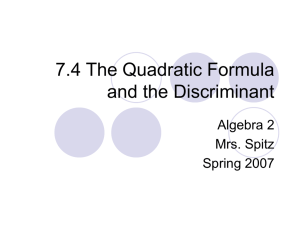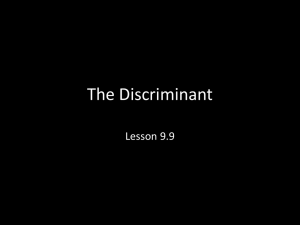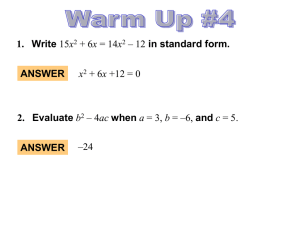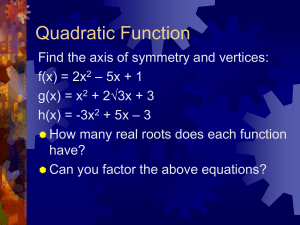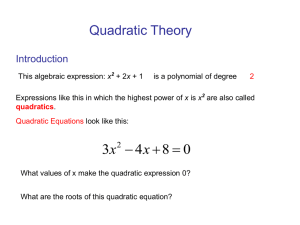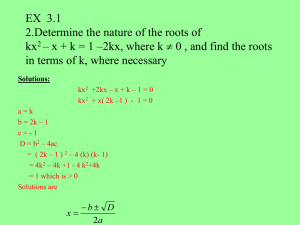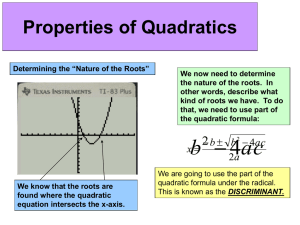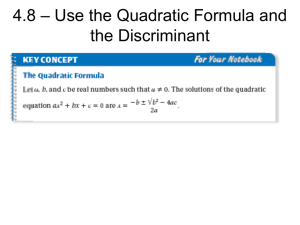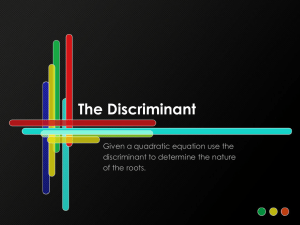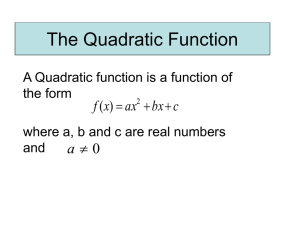Solutions
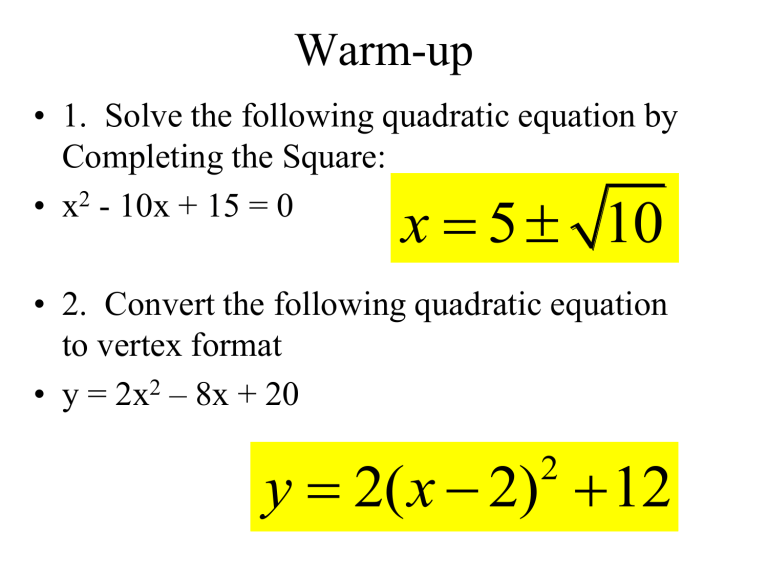
Warm-up
• 1. Solve the following quadratic equation by
Completing the Square:
• x 2 - 10x + 15 = 0 x 5 10
• 2. Convert the following quadratic equation to vertex format
• y = 2x 2 – 8x + 20 y
2( x
2)
2
12
Chapter 4
Section 4-8
The Discriminant
Objectives
•
I can
calculate the value of the discriminant to determine the number and types of solutions to a quadratic equation
.
Quadratic Review
• Quadratic Equation in standard format:
• y = ax 2 + bx + c
•
Solutions (roots) are where the graph crosses or touches the x-axis.
• Solutions can be real or imaginary
Types of Solutions
Complex Number System
Real Numbers Imaginary Numbers
Rational Irrational
Types of Solutions
2 Real
Solutions
1 Real
Solution
2 Imaginary
Solutions
x
b
2
4 ac
2 a
2
What value of b -4ac gives each solution type?
Key Concept for this Section
• What happens when you square any number like below:
• x 2 = ?
• It is always
POSITIVE!!
• This is always the biggest mistake in this section
Key Concept #2
• What happens when you subtract a negative number like below:
• 3 - -4 = ?
• It becomes
ADDITION !!
• This is 2 nd biggest error on this unit!
The Quadratic Formula
• The solutions of any quadratic equation in the format ax 2 + bx + c = 0, where a
0, are given by the following formula:
• x =
b
b
2
4 ac
2 a
The quadratic equation must be set equal to ZERO before using this formula!!
Discriminant
• The discriminant is just a part of the quadratic formula listed below:
b
2
– 4ac
• The value of the discriminant determines the number and type of solutions.
Discriminant Possibilities
Value of b 2 -4ac
> 0
Discriminant is a Perfect
Square?
Yes
# of
Solutions
2
Type of
Solutions
Rational
No > 0
< 0
2
2
Irrational
Imaginary
= 0 1 Rational
Example 1
• What are the nature of roots for the equation:
• x 2 – 8x + 16 = 0
• a = 1, b = -8, c = 16
• Discriminant: b 2 – 4ac
• (-8) 2 – 4(1)(16)
• 64 – 64 = 0
• 1 Rational Solution
Example 2
• What are the nature of roots for the equation:
• x 2 – 5x - 50 = 0
• a = 1, b = -5, c = -50
• Discriminant: b 2 – 4ac
• (-5) 2 – 4(1)(-50)
• 25 – (-200) = 225, which is a perfect square
• 2 Rational Solutions
Example 3
• What are the nature of roots for the equation:
• 2x 2 – 9x + 8 = 0
• a = 2, b = -9, c = 8
• Discriminant: b 2 – 4ac
• (-9) 2 – 4(2)(8)
• 81 – 64 = 17, which is not a perfect square
• 2 Irrational Solutions
Example 4
• What are the nature of roots for the equation:
• 5x 2 + 42= 0
• a = 5, b = 0, c = 42
• Discriminant: b 2 – 4ac
• (0) 2 – 4(5)(42)
• 0 – 840 = -840
• 2 Imaginary Imaginary
GUIDED PRACTICE for Example 4
Find the discriminant of the quadratic equation and give the number and type of solutions of the equation.
4.
2 x 2 + 4 x
– 4 = 0
SOLUTION
Equation ax 2 + bx + c = 0
2 x 2 + 4 x
– 4 = 0
Discriminant
4 b
2
2 – 4 ac
– 4(2)(– 4 )
= 48
Solution(s) x =
– b + b 2 – 4 ac
2 ac
Two irrational solutions
GUIDED PRACTICE for Example 4
5.
3 x 2 + 12 x + 12 = 0
SOLUTION
Equation ax 2 + bx + c = 0
3 x 2 + 12 x + 12 = 0
Discriminant b 2 – 4 ac
12 2 – 4(12)(3 )
= 0
Solution(s) x =
– b + b 2 – 4 ac
2 ac
One rational solution
GUIDED PRACTICE for Example 4
6.
8 x 2 = 9 x – 11
SOLUTION
Equation ax 2 + bx + c = 0
Discriminant b 2 – 4 ac
8 x 2 – 9 x + 11 = 0 (– 9) 2 – 4(8)(11 )
= – 271
Solution(s) x =
– b + b 2 – 4 ac
2 ac
Two imaginary solutions
GUIDED PRACTICE for Example 4
7.
7 x 2 – 2 x = 5
SOLUTION
Equation ax 2 + bx + c = 0
7 x 2 – 2 x
– 5 = 0
Discriminant b
(– 2)
2
2
– 4 ac
– 4(7)(– 5 )
= 144
Solution(s) x =
– b + b 2 – 4 ac
2 ac
Two rational solutions
• WS 7-2
Homework

